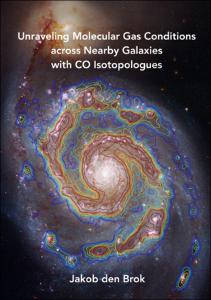Unraveling Molecular Gas Conditions across Nearby Galaxies with CO Isotopologues

Unraveling Molecular Gas Conditions across Nearby Galaxies with CO Isotopologues

| dc.contributor.advisor | Bigiel, Frank | |
| dc.contributor.author | den Brok, Jakob Sebastiaan | |
| dc.date.accessioned | 2022-12-07T10:18:43Z | |
| dc.date.available | 2022-12-07T10:18:43Z | |
| dc.date.issued | 07.12.2022 | |
| dc.identifier.uri | https://hdl.handle.net/20.500.11811/10508 | |
| dc.description.abstract | In general, we associate large spatial scales, heavy massive objects, and great distances with the scientific study of Astronomy. However, in this thesis, we study the tiny hydrogen molecule, H2, which populates interstellar space. An intricate interplay exists between the molecular gas in the interstellar medium (ISM) and its capacity to form stars. Gaining insight into the composition of the molecular gas, as well as its physical and chemical conditions, is crucial to comprehending how star formation proceeds and how galaxies evolve. However, H2 is difficult to observe directly under the commonly cold ISM conditions. Nowadays, Carbon Monoxide (CO) emission has become the most accessible tracer of the bulk molecular ISM distribution. In combination with various CO isotopologues, we can start to grasp the full extent of molecular gas conditions. This thesis analyses CO and its isotopologue line emission within and across entire nearby galaxies.
We draw on observations from various large programs of millimeter observatories, such as the IRAM 30m telescope and ALMA. The first scientific project investigates the R21 = 12CO (2-1)/(1-0) line ratio. It is common to rely on 12CO (2-1) to trace molecular gas mass after converting it down to the J = 1 → 0 transition using R21. This line is advantageous because its brightness and frequency allow more efficient mapping. However, R21 varies due to its sensitivity to the temperature and density of the gas. This project presents a major systematic analysis of the line ratio across nine nearby galaxies on kiloparsec-scales. We show that it is important to account for R21 variation, in particular, toward the center of galaxies, where the line ratio generally increases by 10–20% to the galaxy-wide average. The second project presents the first insights from the CLAWS IRAM 30m large program that targets M51. We present the first resolved detection of numerous faint CO isotopologues, such as 13CO, C18O, and even C17O, across the full disk of a regular star-forming galaxy. We assess the CO isotopologue line ratio trends and conclude that selective nucleosynthesis and optical depth effects dominate the observed kpc-scale variation across M51. Overall, the project provides a benchmark study on kpc-scales and opens the way for future CO isotopologue studies in nearby galaxies. The thesis also presents a wide-field IRAM 30m study of CO isotopologues M101. Using SED-fit-based dust mass estimates, we systematically estimate the CO-to-H2 conversion factor across the galaxy. This study goes beyond recent research by combining the conversion factor analysis across a full nearby galaxy with the investigation of R21 variation. We find that the center shows significantly lower conversion values by a factor of 10. This highlights the need to account for a variable αCO value when we derive molecular gas mass scaling relations, such as the Kennicutt-Schmidt law. Throughout the thesis projects, we take special care in understanding telescope systematics that hamper the sensitivity and quality of the observations. We investigate flux calibration stability and the error beam contribution for the 30m telescope. We find that an uncertainty of 10–15% needs to be considered when dealing with millimeter single-dish observations. Such an in-depth observation uncertainty analysis is rarely found in the literature. But it is essential and helps us to correctly interpret the line emission and ratio trends. We have investigated the main tracer for molecular gas across entire nearby galaxies. We also assessed relevant systematic effects that can hamper our observations. As such, the thesis projects offer detailed diagnostics on accurately accounting for and interpreting the variation of CO-derived properties of the molecular ISM. Furthermore, this research helps to advance future studies toward higher resolution observations that will help us understand the small-scale mechanisms that regulate star formation and connect them to the large-scale dynamical processes across galaxies | en |
| dc.language.iso | eng | |
| dc.rights | In Copyright | |
| dc.rights.uri | http://rightsstatements.org/vocab/InC/1.0/ | |
| dc.subject.ddc | 520 Astronomie, Kartografie | |
| dc.title | Unraveling Molecular Gas Conditions across Nearby Galaxies with CO Isotopologues | |
| dc.type | Dissertation oder Habilitation | |
| dc.publisher.name | Universitäts- und Landesbibliothek Bonn | |
| dc.publisher.location | Bonn | |
| dc.rights.accessRights | openAccess | |
| dc.identifier.urn | https://nbn-resolving.org/urn:nbn:de:hbz:5-68971 | |
| dc.relation.doi | https://doi.org/10.1093/mnras/stab859 | |
| dc.relation.doi | https://doi.org/10.1051/0004-6361/202142247 | |
| dc.relation.doi | https://doi.org/10.1051/0004-6361/202243766 | |
| dc.relation.doi | https://doi.org/10.3847/1538-4357/ac3490 | |
| dc.relation.doi | https://doi.org/10.1051/0004-6361/202142624 | |
| dc.relation.doi | https://doi.org/10.3847/1538-4365/ac17f3 | |
| dc.relation.doi | https://doi.org/10.1093/mnras/stab1776 | |
| ulbbn.pubtype | Erstveröffentlichung | |
| ulbbnediss.affiliation.name | Rheinische Friedrich-Wilhelms-Universität Bonn | |
| ulbbnediss.affiliation.location | Bonn | |
| ulbbnediss.thesis.level | Dissertation | |
| ulbbnediss.dissID | 6897 | |
| ulbbnediss.date.accepted | 24.11.2022 | |
| ulbbnediss.institute | Mathematisch-Naturwissenschaftliche Fakultät : Fachgruppe Physik/Astronomie / Argelander-Institut für Astronomie (AIfA) | |
| ulbbnediss.fakultaet | Mathematisch-Naturwissenschaftliche Fakultät | |
| dc.contributor.coReferee | Menten, Karl M. | |
| ulbbnediss.contributor.orcid | https://orcid.org/0000-0002-8760-6157 | |
| ulbbnediss.contributor.gnd | 1239772319 |
Files in this item
This item appears in the following Collection(s)
-
E-Dissertationen (4104)




